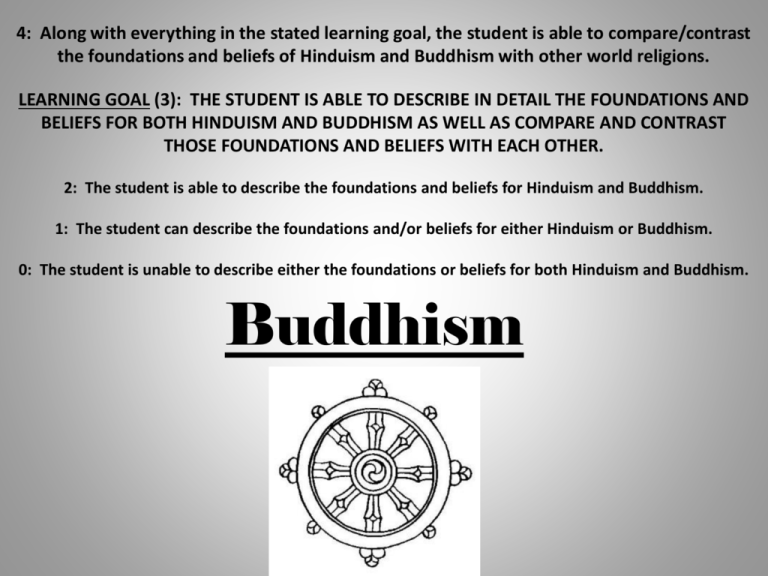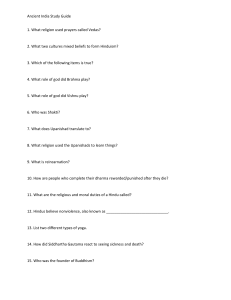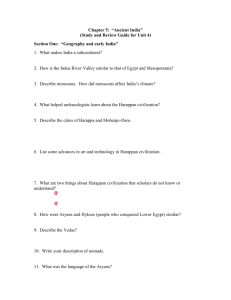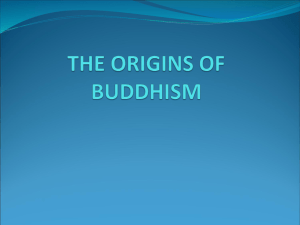Buddhism
advertisement

4: Along with everything in the stated learning goal, the student is able to compare/contrast the foundations and beliefs of Hinduism and Buddhism with other world religions. LEARNING GOAL (3): THE STUDENT IS ABLE TO DESCRIBE IN DETAIL THE FOUNDATIONS AND BELIEFS FOR BOTH HINDUISM AND BUDDHISM AS WELL AS COMPARE AND CONTRAST THOSE FOUNDATIONS AND BELIEFS WITH EACH OTHER. 2: The student is able to describe the foundations and beliefs for Hinduism and Buddhism. 1: The student can describe the foundations and/or beliefs for either Hinduism or Buddhism. 0: The student is unable to describe either the foundations or beliefs for both Hinduism and Buddhism. Buddhism IMAGINE THIS SCENARIO: Imagine that today, for the first time in your lives, you learned that the following things existed because you were sheltered from them. • Poverty • Disease • Violence • Death What do you think you’re reaction would be??? The Rise of Buddhism Around the year 550 B.C., a young Hindu prince name Siddhartha Gautama found himself in the same situation as we discussed. He gave up his wealth and high standing Caste system position to try and understand the meaning of life. Later, when he began to teach what he had learned he was called Buddha, or enlightened one. The Buddha’s Early Life Siddhartha Gautama was born a Hindu prince. As a child, a priest had predicted that he would become a wandering holy man. To prevent this, Siddhartha’s father gave his son every luxury and sheltered him. Siddhartha did not see old age, illness, death, or poverty until he was 29. When he finally did see such troubles, they upset him. He fled from his home to search for peace in a world of suffering. THE STORY GOES……. For six years, Siddhartha starved himself, but this sacrifice did not help him find the answers he sought. Then he sat under a fig tree and meditated until he found understanding. This gave him insights into reality. According to Buddhist teaching, as Siddhartha Gautama sat meditating, an evil spirit tempted him to stop seeking truth. First the spirit sent beautiful women, but Siddhartha ignored them. Then flaming rocks began to rain down on him. But as they drew close to Siddhartha, they became flower petals. Finally, the evil spirit asked what right Siddhartha had to look for truth. Siddhartha ignored the evil spirit and continued on with his meditation. That night Siddhartha’s meditation grew even deeper, and he received his great insights. He had become the Buddha. The evil spirit decided to tempt him one last time. “No one will understand your deep truths,” the evil spirit taunted. The Buddha simply answered, “Some will understand.” Four Noble Truths 1) People suffer because their minds are not at ease. 2) That condition comes from wanting what one doesn’t have or from wanting life to be different. 3) People can stop suffering by not wanting. 4) People can stop wanting by following the Eightfold path. “Attachment is the root of all suffering.” ~Buddha The Eightfold Path The Buddha’s Teachings The Buddha taught people that following the Eightfold path could lead to nirvana (the end of suffering). Reaching nirvana broke the cycle of reincarnation that the Buddhists, as well as Hindus, believed in. The Buddha believed in the practice of ahimsa (nonviolence). He didn’t worship Hindu gods and goddesses. He also rejected the idea that people in the upper castes were holier than others. “Gripped by fear, men go to the sacred mountains, sacred trees, sacred groves and shrines.” ~Buddha Many Buddhists do not believe in a god or gods. They believe that the idea of a higher power brings fear to the minds of men, and thus, brings suffering. In essence, Buddhism is a religion that believes you don’t have to believe in anything….you just have to see and accept reality for what it is, not what you want it to be or what you’re told it is. Buddhism Changes http://safeshare.tv/w/LUDzKaMAsP After the Buddha’s death in 483 B.C., his followers gathered his teachings to pass on to others. These collected teachings are called the Dharma, which means the true nature of things. Dharma is often shown symbolically as a wheel. Monks and nuns – men and women who live in religious communities – helped develop the formal religion of Buddhism. Other Buddhists became wandering holy men and tried to live as Buddha had. Over time, Buddhism split into many branches. Some branches stressed the importance of being a monk and studying the Buddha’s life. Others stressed meditation. Some Buddhists taught that ordinary people could become Buddhas. Such holy people could work to save others through acts of mercy and love. Most Buddhists worshiped the Buddha as a divine being. Buddhism is the worlds 4th largest religion, with 7.1% of the world’s population following the teachings of the Buddha. Only an estimated 3% of India today is Buddhist. Buddhism spread east and is the primary religion in many eastern Asian countries. China alone has an estimated 110,000,000 people who follow Buddhism.








